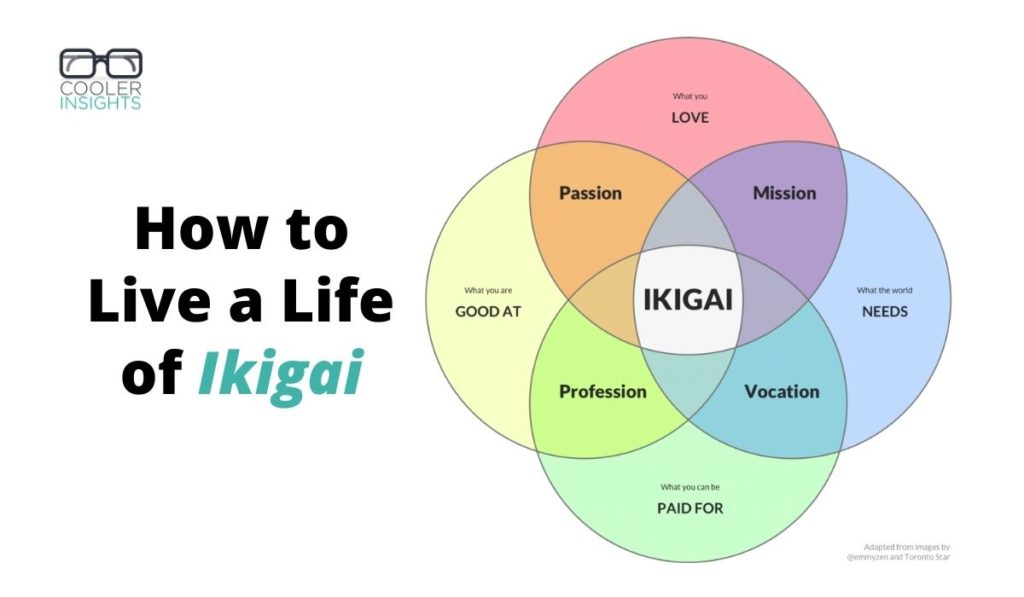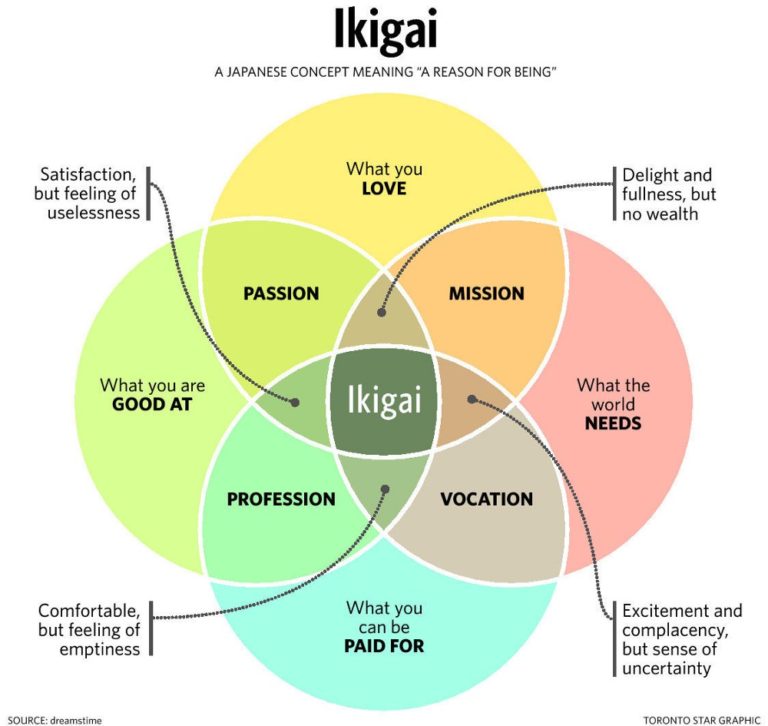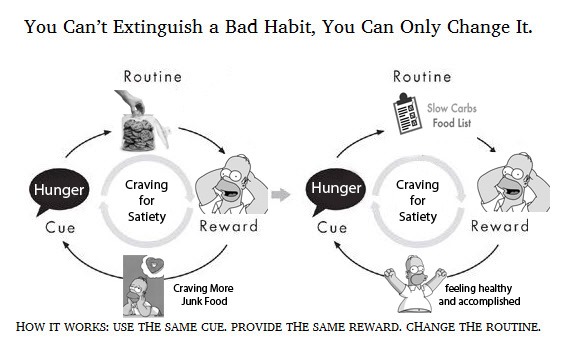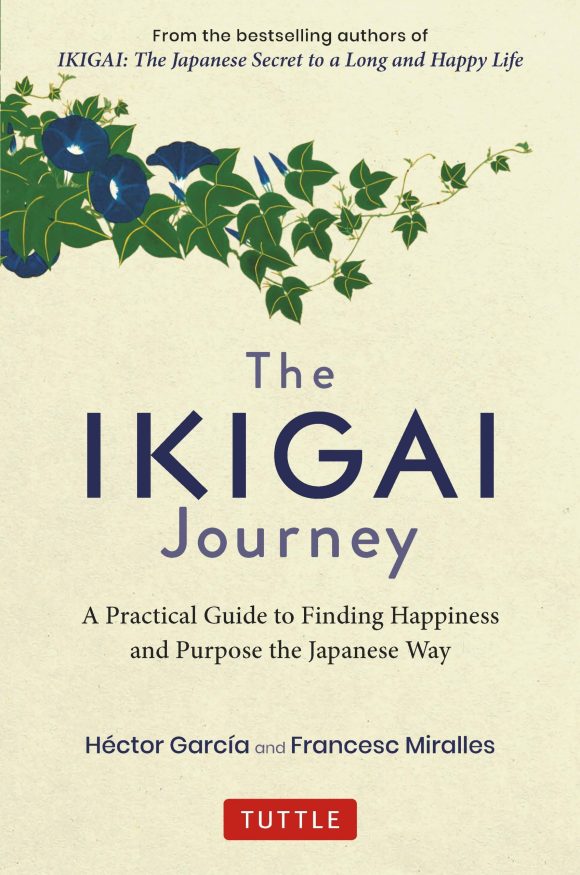
Like me, you’ve probably read or heard of the term ikigai.
However, what exactly does ikigai mean? And how can you live a life focused on your ikigai?
In this article, you will learn some of the basic principles of ikigai plus practical steps you can take to live a life of happiness, fulfillment and purpose centred on the Japanese philosophy of ikigai.
Much of the material here are extracted from the wonderful book The Ikigai Journey — A Practical Guide to Finding Happiness and Purpose the Japanese Way by Spanish authors Héctor García and Francesc Miralles. I highly recommend that you pick up a copy to dive more in-depth into these principles.
What is Ikigai
Ikigai (written as 生き甲斐) is a Japanese concept defined as the meaning of life or the reason for being. It comprises two words:
- iki (生) which means “life” or “being alive” and
- gai (甲斐) which means something of value that is worthwhile
Taken together, it translates to “that which makes life worth living.”
This can be understood as your raison d’être (reason for existence) while possessing a clear direction and purpose.
Your ikigai also gives you meaning, purpose and satisfaction in what you do — it provides the spark that gets you out of bed every morning.
How to Find Your Ikigai
To discover your life goals and find out what your ikigai is, you need to uncover the intersection between the four components of ikigai.
This is illustrated by the diagram below:

Courtesy of Toronto Star
#1 What You Love
What are the things that you enjoy doing? What gives you that zest and spark in life?
Write down everything that you enjoy and end each sentence with “____________ makes me happy.”
#2 What The World Needs
Consider what others need — they can be your friends, family, or even the world. Use these formats:
- “My beloved ______________ needs _______________”
- “The world needs _________________________”
- “My wife currently needs _________________________”
- “My colleagues are in need of ____________________”
#3 What You Can Be Paid For
This is important to sustain yourself. You should write down both your present and future sources of income. (Your future sources will help to drive your actions.)
- Present: “Now I make a living by ___________________”
- Future: “In the future, I would like to earn money by _____________________”
#4 What You Are Good At
Like the earlier point, it is useful to consider what you are currently good at, and what you aspire to be good at in the future.
- Present: “I’m good at _________________________________”
- Future: “In the future, I can be good at ______________________ if I prepare myself by doing _______________”
Take Action!
“The only place where Success comes before Work is in the dictionary.” — Donald Kendall
Once you’ve identified the four quadrants of your ikigai, your next act is to take action. This is especially critical for the areas that overlap in the middle and form your ikigai.
35 Ways to Live Your Ikigai
To help you to take the right action, the authors came up with 35 principles to act on and live out your ikigai.
Using the metaphor of a Japanese train and its stations, they’re separated into three main areas:
- The Future: Using the ultra-modern bullet train in Tokyo as an example, you’ll learn exercises to help you design and envision your potential in the future.
- The Past: Using the city of Kyoto as a base, you’ll uncover ways to “know yourself” better and reflect on what makes you tick.
- The Present: Using the Ise Grand Shrine (a building that is intentionally destroyed and rebuilt every 20 years) as an analogy, you’ll learn how to stay focused in the present.
Hop on for the ride with me now!
#1 Adopt Shinkansen Thinking
Set an impossibly difficult goal to achieve and write it down.
Wish to be a millionaire before 30? Write it down.
Want to play a violin in front of presidents? Write it down!
#2 Scale Mount Fuji Daily
Include at least one “impossible venture” in your day-to-day activity.
#3 Practice Gambarimasu
Practice being patient and persevere through your difficulties. Adopt the principles of the 10,000-hour rule and deliberate practice!
#4 Build Positive Habits
Discard bad habits and embrace good habits — learn how you can master them here.

#5 Seek Feedback
Get feedback — particularly negative ones that can help you to improve — from the people whom you trust.
Use the SKS method:
- STOP: What should I stop doing?
- KEEP: What should I keep doing?
- START: What should I start doing?
#6 Engage the Help of Mentors
Proactively find a senpai (senior) who can help you to be a better version of yourself.
#7 Emulate the Leaders and Modify Them For Yourself
Copy, adapt, and modify what others do to improve on what you do. Don’t be afraid to look outside your industry!
#8 Uncover Your Element
Find your element — the proverbial “sweet spot” where what you love doing and what you are good at coincide.
Eliminate everything else.
#9 Embrace a Life of Virtue
Like Benjamin Franklin, get a little notebook where you can list down areas of self improvement that you should develop each week. Write down what you should.
#10 Organise Focused Problem Solving Sessions
Also known as “scrum” sessions (or hackathons), these are hyper-focused sessions where you work with others to solve a problem together.
#11 Be Adventurous
Seek novel experiences and places — get out of your comfort zone to stretch yourself.
#12 Focus on the Important
Eliminate distractions like social media scrolling, binge watching, and others.
#13 Adopt Pareto’s 80/20 Rule
Prioritize your time and energy on the vital few — work, leisure, friends, and activities. (See how it works in content marketing.)
#14 Name Your Projects
A rose by any other name may smell just as sweet. However, a memorable name helps your project to stand out better.
#15 Relive Your Childhood Dreams
Rekindle your childhood dreams and write down what you wanted to be.
Be like Randy Pausch, who did not regret how he lived his life (even though it wasn’t long). (Read how he lived in The Last Lecture.)
#16 Tap the Power of Personal Nostalgia
Uncover and relive your greatest achievements in life and work. These will help you to power your way through tough times.
#17 Prioritize Your Top Friends
Review who your closest and most dependable friends are, and lavish them with the attention they deserve.
#18 Connect the Dots — Past to Present
Jot down the significant milestones of your past, and examine them to see how they correlated to your present.
Use this to plan your future.
#19 Detox from Digital Devices
Spend time on “analog” hobbies and offline leisure pursuits that helps you to truly connect with your inner self. Live a life of digital minimalism.
#20 Slow Down to Savour Life
Unplug from the grid and savour the taste of your food, or enjoy taking a slow walk. Make your leisure hurry-free.
#21 Focus on One Thing at a Time
Observe what you are doing and be fully present. Be a mono-tasker, not a multi-tasker. (Here’s why.)
#22 Journal Your Life
Write every day if you can, and create a logbook of your life. This can be a physical or digital daily diary, where you reflect on:
- Morning: Three things you are grateful for
- Morning: Three things that will make the day ahead special
- Morning: Statement of the day: Today I am going to _________
- Night: Three great things that happened today
- Night: How I could make today better (remember not to judge yourself)
#23 Write a Haiku (or Two)
Tap into your inner emotions by adopting the art of Japanese Haiku. Here’s how.
#24 Take Stock of Crucial Decisions
List down the crucial decisions which you’ve made in the past, followed by those which you need to make moving forward.
#25 Dive Deep into Your Dreams
Leverage on the power of lucid dreaming to help you solve problems as you “sleep over” them. Learn how you can use lucid dreaming here.
#26 Draw the Enso (円相) Circle
Adopt the practice of calligraphy by drawing an enso circle. This helps you to clear your mind of worries and concerns as you start on an important task.
#27 Solve a Koan to Develop Lateral Thinking
Learn to see a problem in a novel way by adopting lateral thinking. To do so, try to solve a koan which is a “question which aims to confound the student’s mind in order to activate their lateral thinking, thereby destroying logical thinking patterns.”
Here are some examples:
- What doesn’t the bird fly?
- If a tree fell in the forest and nobody was around to see it, did it fall?
- Why is there lots of water in the sea, but sailors still die of dehydration?
- How does your face look like before you were born?
#28 Cultivate Mindfulness
Zoom in fully on the present, and give it your undivided attention. Be fully aware of what you’re feeling and sensing, and let the thoughts drift by.
(Read about mindfulness in marketing here.)
#29 Value Serendipity
Allow the happy accidents and coincidences in life to carry you along. Add randomness to your life by doing novel things or organising events that defy convention.
#30 Practice Random Acts of Kindness
Do one random and altruistic act every day if you can.
#31 Tap the Healing Properties of Touch
Remember to hug, kiss and touch your loved ones each day. (Of course, do it mindfully with strangers — you don’t want to be accused of wrongful affection!)
#32 Travel without an Itinerary
Let your heart and spontaneity guide you when you travel. And if you’re stuck in your home country, inject some uncertainty into your day!
#33 Plan Do Check and Act (PDCA) the Kaizen Way
Tap the practices of continuous improve to sharpen your saw each and every day:
- Plan: Set your goals and steps needed for each action
- Do: Carry out the plan and collect data during execution
- Check: Analyse the results that you’ve garnered from your Do stage
- Act: Determine if you should carry on, or to make adjustments
#34 Adopt the Art of Kyudo (Archery)
Exercise your mind, body and spirit each day. Be patient and persevere through your weakness, and be humble and flexible to improve.
#35 Toshogu — See no Evil, Hear No Evil, Speak No Evil

The Three Monkeys from Toshogu Shrine (courtesy of Wikimedia Commons)
Refrain from absorbing negativity, spreading negativity, or engaging in negative behaviours.
Use Socrates’ three filters: check if something is truthful, kind and necessary before we indulge in it.
Conclusion — an Invaluable Personal Development Roadmap
The Ikigai Journey is a practical guide for all of us to live our best life. Beyond the Japanese concept of ikigai, it further taps onto some of the lessons from leading productivity and personal development experts in this day and age.
Personally, I’m going to practice some of these precepts in my daily life. What about you?

